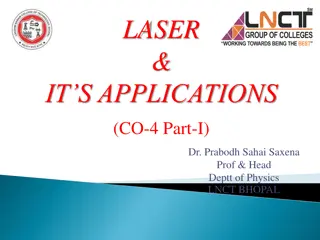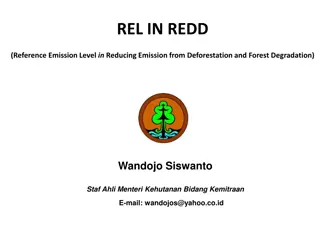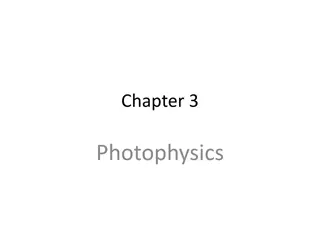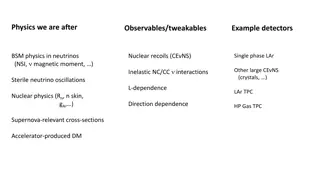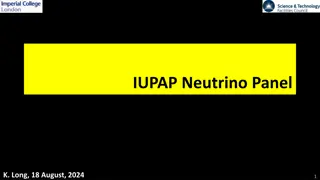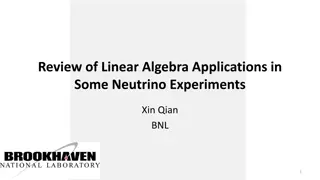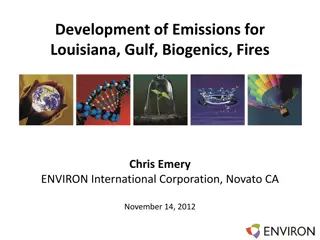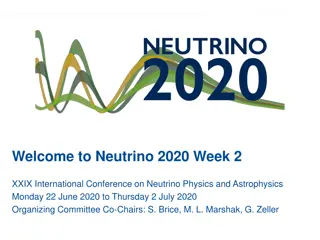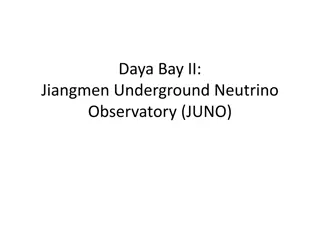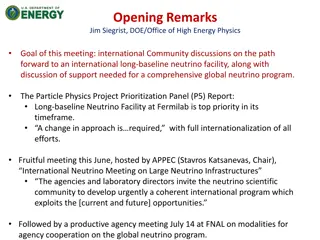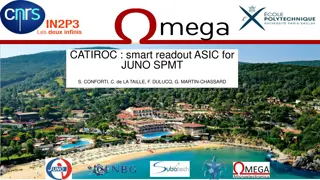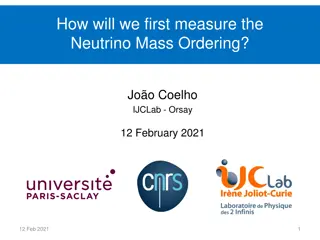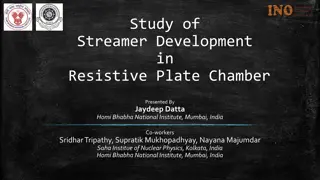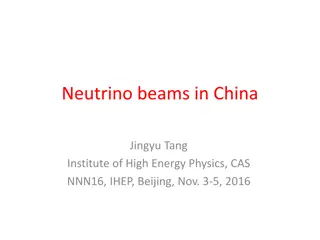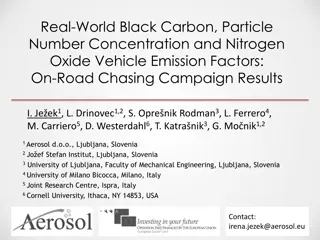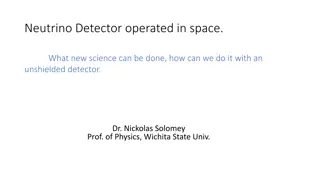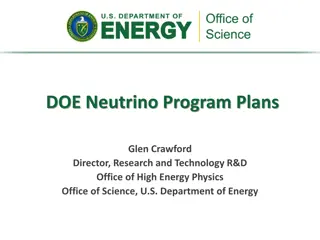Late-Time Neutrino Emission Impact on DSNB Study
Explore the implications of late-time neutrino emission on the Diffuse Supernova Neutrino Background (DSNB) through core collapse supernovae simulations. The research delves into the dynamics of neutrino emission in different phases of supernova events and its relevance to understanding the DSNB.
Download Presentation

Please find below an Image/Link to download the presentation.
The content on the website is provided AS IS for your information and personal use only. It may not be sold, licensed, or shared on other websites without obtaining consent from the author.If you encounter any issues during the download, it is possible that the publisher has removed the file from their server.
You are allowed to download the files provided on this website for personal or commercial use, subject to the condition that they are used lawfully. All files are the property of their respective owners.
The content on the website is provided AS IS for your information and personal use only. It may not be sold, licensed, or shared on other websites without obtaining consent from the author.
E N D
Presentation Transcript
Impact of late time neutrino emission on the DSNB (Ekanger et al., in prep) Nick Ekanger 1
Core Collapse Supernovae (CCSNe) Infalling material bounces off core, pressure shock wave Neutrinos revive shock, cooling protoneutron star [1] 8 ? , Iron fused in core of progenitor, radiation pressure decreases ? ~1.4 ? core collapses, ? + ? ? + ??, neutron degeneracy [1] Burrows et al. (2021) 2 Virginia Tech CNP Research Day 2022 Core collapse supernovae
Neutrinos from CCSNe [1] Early signal: High luminosity, high mean energy from accretion Simulations typically focus on this Late signal: After shock revival, PNS cools Luminosity and mean energy decrease SN1987A only case of SN neutrinos [1] Li et al. (2021) 3 Virginia Tech CNP Research Day 2022 Core collapse supernovae
Neutrinos from Simulation Estimate neutrino emission from simulations: Robust, dynamic mass accretion phase Few with long term cooling components [1] [1] Bollig et al. (2021) 4 Virginia Tech CNP Research Day 2022 Core collapse supernovae
Diffuse Supernova Neutrino Background (DSNB) [1] Sum distribution of CCSNe over cosmological history Individual CCSNe events cannot be detected Detectable at SK through IBD ??+ ? ?++ ? Gadolinium upgrade (SK-Gd) [2] [1] https://www.businessinsider.com/super-kamiokande-neutrino-detector-is-unbelievably-beautiful-2018-6 [2] https://www.mpi-hd.mpg.de/WIN2015/talks/neutrino2_ikeda.pdf 5 Virginia Tech CNP Research Day 2022 Diffuse Supernova Neutrino Background
DSNB Uncertainty [2] CC Rate (from SFR) DSNB uncertainty Failed SNe (BH) Cooling phase Neutrino emission Accretion Phase Successful SNe (NS) PNS Cooling [1] [1] Abe et al. (2021) [2] Li et al. (2021) 6 Virginia Tech CNP Research Day 2022 Diffuse Supernova Neutrino Background
First, Set the Stage [1] Our Model 3D simulations give neutrino emission for accretion phase Assume standard SFR Neutrino emission from BH Choose conservative BH fraction: (M > 40 ? , ~10%) Signal from two 40 ? simulations Need cooling phase neutrino emission [2] [3] [1] Burrows et al. (2021) [2] Yuksel et al. (2008), Horiuchi et al. (2011) [3] Hudepohl (2014) 7 Virginia Tech CNP Research Day 2022 Estimate the Cooling Phase
Estimate Cooling Phase 5 Ways Need mean energy and energy liberated by neutrinos 50% of energy liberation occurs in cooling phase! Without many long-term multi-dimensional simulations, we estimate the cooling phase by: 1. Constant mean energy 2. Analytical solution 3. Correlation method 4. Renormalized correlation methods Shen EOS LS220 EOS 8 Virginia Tech CNP Research Day 2022 Estimate the Cooling Phase
Constant Mean Energy ( Const ) Mean energy: Assume it retains value at end of simulation Expected to reduce as PNS cools, so represents upper limit Liberated energy: Assume ~energy liberated = gravitational binding energy Determined from PNS mass/radius and SFHo EOS 9 Virginia Tech CNP Research Day 2022 Estimate the Cooling Phase
Analytic Solution ( Analyt ) Analytic function to estimate neutrino luminosity and mean energy PNS info: mass, radius, total energy liberated + correction factors for density (g) and scattering off heavy nuclei (?) [1] g, ? adjusted to best fit mean energy Mean energy ~ reasonable, but luminosity fit is poor Despite this, integrating luminosity ~ grav binding energy [1] Suwa et al. (2021) 10 Virginia Tech CNP Research Day 2022 Estimate the Cooling Phase
Final Mass-Revival Time Correlation ( Corr ) Found linear correlation with 1D cooling phase sims Supernova Neutrino Database Both mean energy and log of liberated energy [1] Greater final mass greater neutrino emission Earlier revival time greater neutrino emission [1] Nakazato et al. (2013) 11 Virginia Tech CNP Research Day 2022 Estimate the Cooling Phase
Renormalized Correlations ( RenormShen/LS ) Neutrino emission from Corr method systematically lower than others Renormalize correlations to another simulation suite Re-fit through data well Depends on EOS: Mean energy differences are large [1] [1] Hudepohl (2014) 12 Virginia Tech CNP Research Day 2022 Estimate the Cooling Phase
Results Total ?? energies: early hydro data + late cooling estimations (~0-20s post-bounce) Corr / Const are lower / upper estimates Liberated energies similar Mean energies drive differences in event rates Factor of ~3 difference in event rates (??) and flux (?) 13 Virginia Tech CNP Research Day 2022 Wrapping up
Conclusion Factor of ~3 difference in predicted DSNB rates at SK-Gd Under current SK flux limits Comes primarily from uncertainty in cooling phase mean energy [1] In absence of many long-term, multidimensional simulations Among 5 methods, recommend RenormLS Recommend Analyt if more simulation data is available [1] Abe et al. (2021) 14 Virginia Tech CNP Research Day 2022 Wrapping up
Thank you! 15



